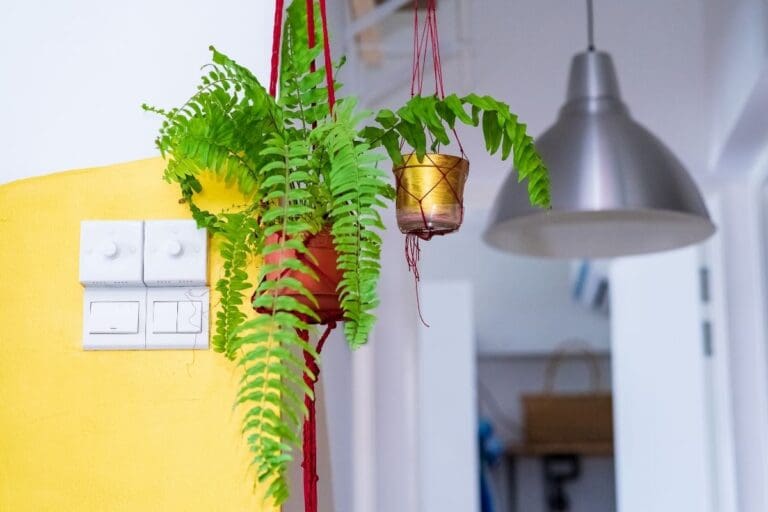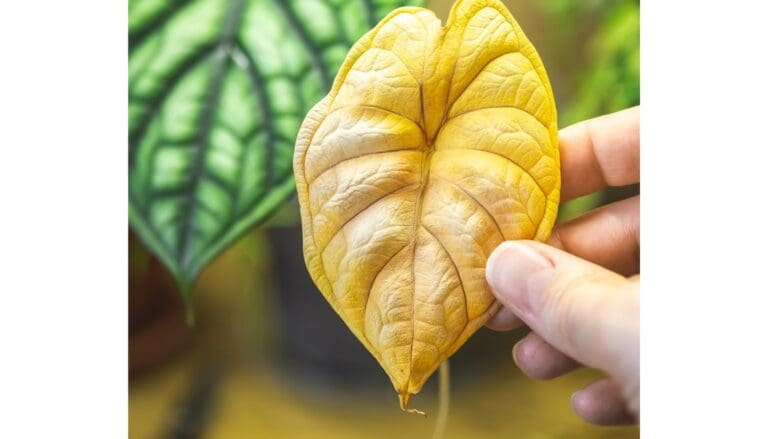5 Reasons Why Your Croton Leaves Are Turning Green
Crotons are beautiful tropical plants grown as houseplants for their vibrant foliage. When the new leaves emerge, they remain green in color and eventually turn yellow or red as time progresses. But sometimes, this bright color fades, leaving the crotons with ordinary green-colored leaves.
What could be the probable reasons behind your croton’s leaves turning green? Is it possible to bring their faded colors back? We will find out in this article.
In general, if the bright colors of crotons fade away or their leaves turn green, then the most common reason would be low light. Other reasons for Croton’s green or faded leaves can be over-fertilization, inappropriate weather conditions, overwatering, and pest infestations.
This article will help you identify all the possibilities that cause croton’s leaves to turn green and suggest ways to make your croton plant more colorful.

Please note: Simplify Plants is reader-supported. Some links in the post are affiliate links and I get a commission from purchases made through links in the post.
Why are my crotons turning green?
If your crotons lose their bright color and start to turn green, it’s a sign that the croton plant is experiencing some problem.
Let’s discuss all the problems one by one.
Inappropriate lighting conditions
Poor lighting is one of the major factors responsible for croton leaves losing their colors.
Vivid anthocyanin pigments are responsible for different colors of croton leaves, such as red and purple.
A sufficient amount of light is essential for forming such pigments.
Photosynthesis is vital for the production of sugars in the presence of sunlight.
The process of photosynthesis in crotons will get affected in low light, and it will lead to a reduction of pigments responsible for the colors of leaves.
The foliage appearance will get destroyed if they don’t get the sunlight it needs for photosynthesis.
Also, the intensity of the light requirement varies from crotons to crotons.
Some species of crotons need more bright light than the other crotons to maintain their beautiful colors.
If the crotons receive too much light, they will lose their colors.
Excessive light will stress and dehydrate the crotons, due to which they will stop performing transpiration to prevent moisture loss.
They will stop photosynthesizing efficiently and not get the energy to maintain the bright colors of their leaves.
You may notice grey patches on their leaves.
So, at such times, you will need to provide them shade.
The best spot for your crotons would be a place where they will receive full sun and filtered or indirect bright light for some varieties.
You can put a curtain on the windows where your plant is placed. This will help the crotons to receive indirect light.
Also read: What Kind Of Light Does A Croton Need? (Croton Light Requirements )
Overfertilization

Crotons can still grow if under-fertilized, but they will undergo many problems if you overfertilize them.
Some fertilizers carry many chemicals, and when you overfertilize the plant, the excess chemical affects its roots.
Most chemicals in the fertilizers are highly soluble salts that burn the plant’s roots, take out water from them, and cause dehydration.
All these conditions stress the crotons, and they lose their bright colors and turn green.
Also read: What Fertilizer Is Good For Croton? (Best Fertilizer For Croton Plant)
Poor weather conditions
Crotons are tropical plants that need a warm and humid environment to grow and thrive.
If crotons are grown in unsuitable conditions, it can impact their foliage appearance, and the colors of the leaf will begin to fade.
Low temperatures are not ideal for your crotons, and prolonged exposure to such conditions will make them lose their colors and make their leaves green.
Also read: What Temperature Can Croton Tolerate? (+Ideal Temperature Range)
Improper watering
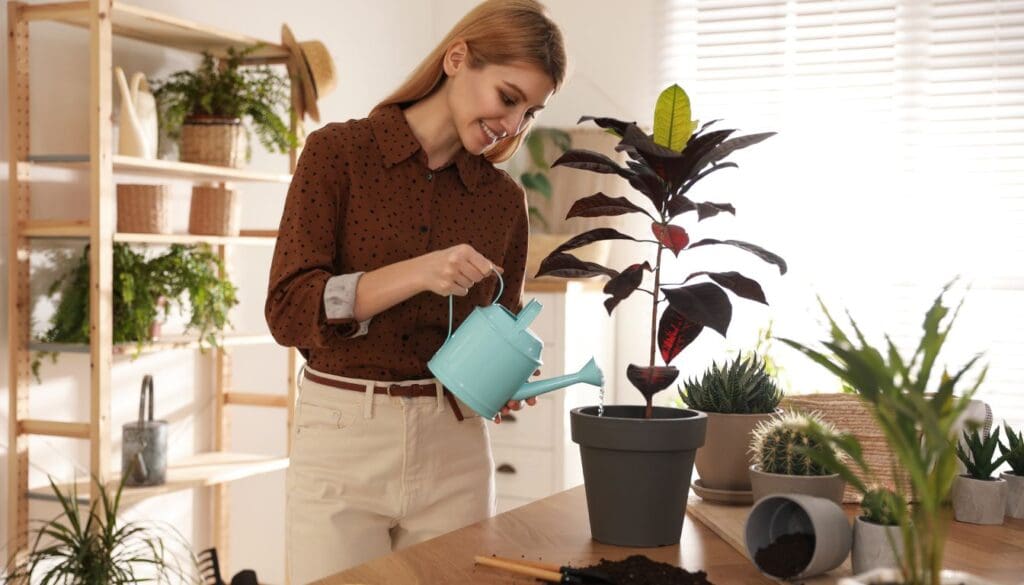
If you underwater your crotons, they will dry out quickly, and due to lack of hydration, the leaves of the Crotons will start to fade.
Watering is essential for your plant’s growth and survival, but the main problem arises when you over-water the plant.
Overwatering will cause stem rot and root rot that will affect foliage appearance.
The excess water in the soil will damage the roots of the plant.
Damaged roots will not be able to pass nutrients to the leaves.
Lack of nutrients will make them weak, and the leaves will fade.
Also read: How Often To Water Croton Plant? (Watering Schedule+Watering Problems)
Pest infestations
If pests infest your plants, they will lose their color.
The bugs will suck out the nutrients from the plants and make them completely weak.
Overwatering, low light, high humidity conditions will attract pests to your plant.
If you don’t treat the pests on time, your plant can even die.
Also read: How Do I Get Rid Of Bugs In My Croton Plant? (Common Bugs+Fix)
How to prevent discoloration in crotons leaves?
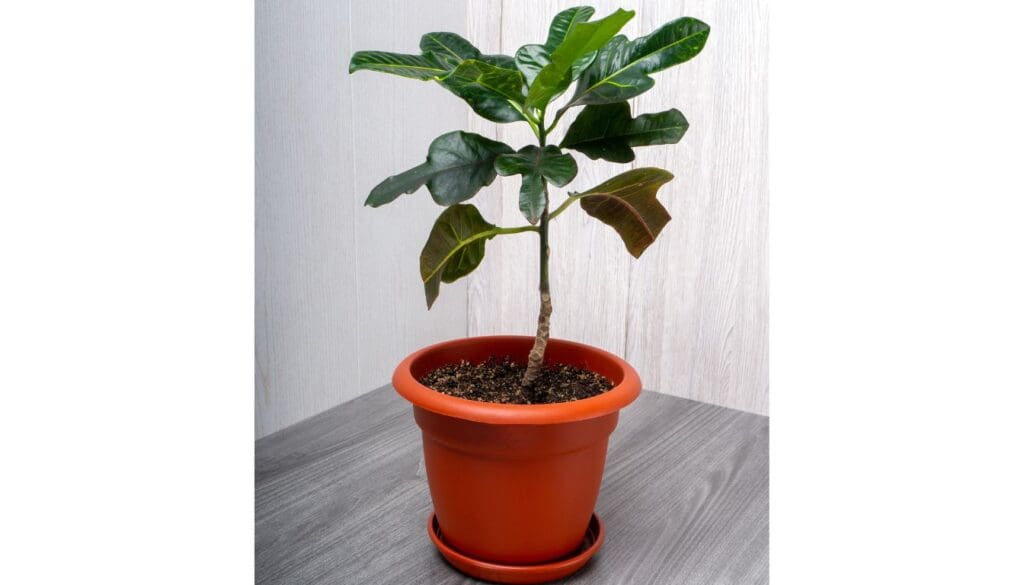
Here are the ways to prevent discoloration in croton leaves and stop them from going green.
Provide your crotons with adequate lightning
If your crotons are not getting sufficient light, you need to move them to a sunny location where they will get a minimum of 7-8 hours of sunlight daily.
You can bring the crotons outdoor during the warmer part of the year to give them more light.
For this, you need to place them in a shadier spot outside for a few hours every day.
Not only will the leaves recover, but the plant will also harden off.
It will also help them adapt to brighter light, less stable temperatures, or winds of the outdoor environment.
Since crotons are not cold-hardy plants, bring them indoors before the first frost arrives.
In winters, you can place the crotons near the sunniest window of your house.
You can also use artificial light to fulfill your lighting needs.
If direct sunlight is the cause of the faded leaves, you need to bring them to a shadier spot or farther away from the window to prevent direct sunlight from reaching them.
Use the right amount of fertilizers
If over-fertilization is the reason behind your croton’s faded or green leaves, you need to take immediate steps to fix this problem.
You can consider soil transplanting.
But remember changing soil will not mean that you will change the surrounding for the plant too.
Crotons will get stressed due to a sudden environmental change.
Also, avoid adding any fertilizers to the new soil mix for around a month, as the plant will require time to recover from over-fertilization.
Later, you can fertilize your plant with a balanced slow-release liquid fertilizer, and it will provide the nutrients they need and improve their foliage appearance.
Use a fertilizer with an NPK ratio of 3-1-2.
For fertilizing, dilute about ½ tablespoon of fertilizer to one gallon of water.
Water your crotons with the fertilizer solution every 2 to 3 weeks during their growing season.
But before fertilizing, read the package instructions carefully, as the amount can vary from brand to brand.
Maintain a watering routine as per their watering needs
If underwatering is the cause of faded leaves of crotons, you should start to water them frequently to improve the condition.
Keep in mind the soil for crotons should remain moist and not wet.
And if overwatering is the cause of their suffering, then reduce watering so that the roots get some room to recover.
Provide your crotons with an inch of water every during the growing season.
Before watering, check the moisture level of the soil by touching it.
Water the croton only when the top inch of the soil seems dry; avoid watering if the soil feels damp to touch.
Also read: How To Save Overwatered Croton Plant? (Signs, Problems & Solution)
Provide your crotons with the correct temperatures and humidity

Crotons being tropical plants, prefer warm temperatures with higher levels of humidity. They will do best when around 60-85°F.
They don’t like cold and can even die from it.
So, it is better to maintain a slightly warm temperature for your croton’s good health.
Ensure that the temperature does not fall below 40°F, as freezing weather can shock them, and their leaves will turn yellow.
Also, being a humidity-loving plant, they will experience a dry environment.
Try to maintain a minimum humidity level of around 40% for any croton variety.
For increasing the humidity levels around the plant, you can put them on a tray filled with pebbles and water.
Replenish the water in the tray when the water level drops below the surface of the pebbles.
The water will evaporate, and it will add humidity to the surrounding.
You can get a humidifier to raise the humidity level as per the plant requirements.
Also, you should frequently mist the leaves of your croton plant twice or thrice a week to keep the surroundings moist around them.
Look out for diseases and pests on croton
If pests are the reason behind your croton’s faded leaves, there are some ways that you can follow to treat pest infestations.
- First, you need to inspect the croton properly and look for the type of pests that have infested it.
- Isolate your croton in one place as soon as you realize it has pests.
- You can give a shower to your plant by putting them under running water.
- Prune all the affected portions of the plant to prevent pests from spreading.
- You can prepare a neem oil solution by mixing two tablespoons with one gallon of water. Spray this solution continuously for 1-2 weeks over the leaves.
- If the pests are too small, you can use a cotton swab to remove them. For this method, you need to dip isopropyl alcohol and rub it on the infected parts of the leaves. Check on the underside of each leaf.
- You can also use insecticidal soaps or non-detergent soaps to get rid of the pests.
- You can also buy specific pesticides or insecticides as per the pest type.
- While your crotons are recovering, avoid keeping them in a moist environment since a moist environment is ideal for the growth of most pests.
Should I cut back the green leaves of my croton?
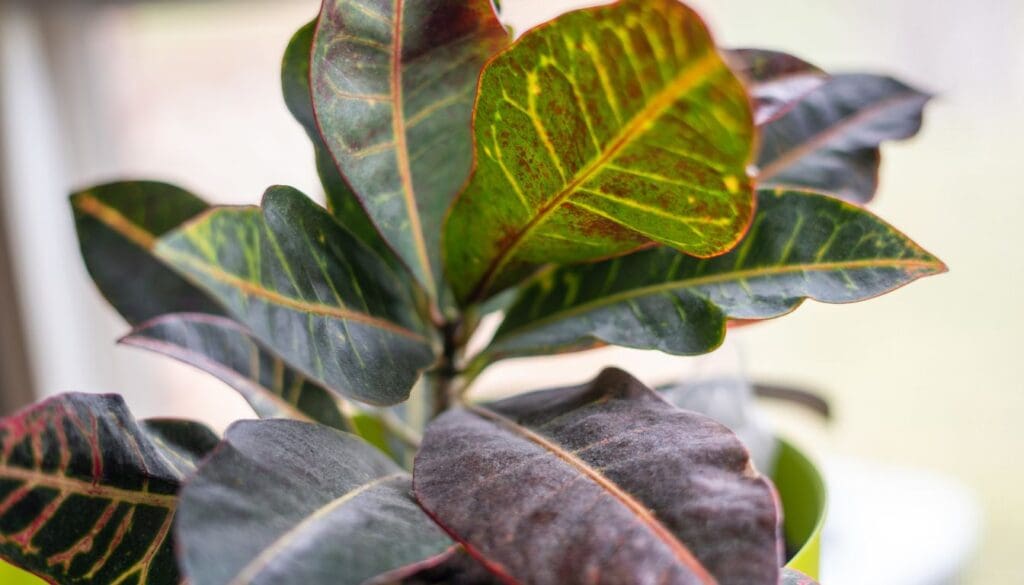
You should prune the leaves of crotons that have turned green out of any deficiency so that the croton will save energy for the new growth in their next growing season.
Also, removing the green leaves will prevent pests and diseases, stopping the plant from getting sparse.
The faded leaves serve no use to the plant, and it takes up the energy and nutrients from it, so pruning is a better option for new leaves to grow.
Pruning doesn’t harm your plant, and it should be done mostly in spring or early summer when they are actively growing.
It is beneficial to prune them during their growing season to help them recover the stress.
But never prune 1/3 portion of a plant at a time, as this can put them under stress.
You should use a fresh pair of pruners or scissors for pruning the plant.
Tips to make your crotons more colorful
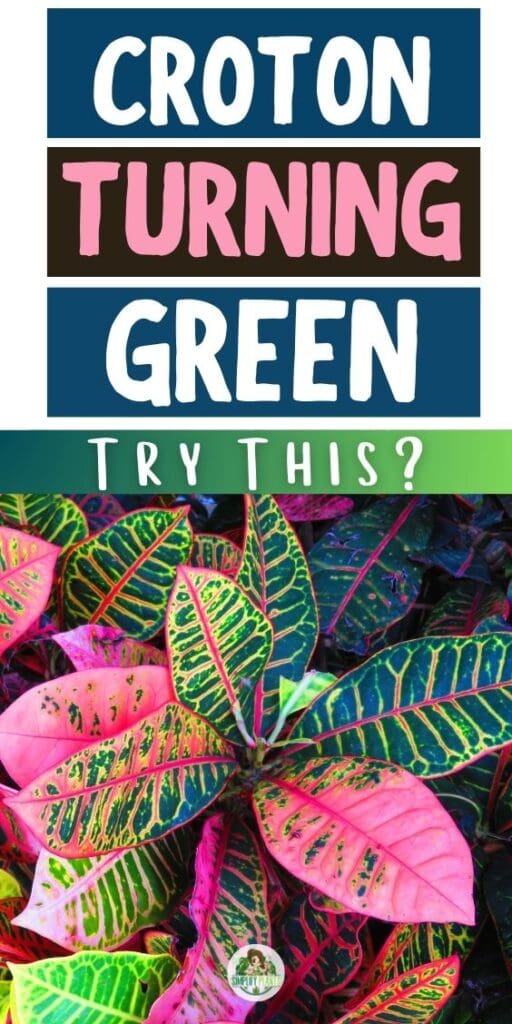
- Place your crotons in a south-facing window so that they get full sun for at least 6 hours.
- If you find the orange or the red leaves are fading in the full sun, you can provide some afternoon shade by bringing them indoors.
- If the croton plant has grey patches, then it is when they are receiving direct sunlight, so at such times bring them to a shadier spot.
- To increase the humidity levels around your croton plant, you can use a pebble tray or a humidifier to elevate the room’s humidity.
- Before fertilizing, read the fertilizing instructions and the amount needed for the plant each time.
- Clean the leaves of your croton plant regularly. Cleaning will remove all the dust particles or fog accumulated on the leaf surface. Also, it prevents pests and diseases from sitting over the leaves. Overall, the color and the beauty of the leaves will enhance.
- To get the best leaf production and size, try to maintain 70°F.
- Keep your crotons plant away from air conditioners, cold Drafty windows, and heating vents.
- Reduce fertilization during the winter season and fall months. This is the dormant period for crotons, and fertilizing them will put them under stress as they do show any growth during this period.
Reference: Sciencedirect, Wikipedia, Wikipedia, Britannica, CABI, Academia, University of South Florida, The University of Georgia.
Recommended Garden Supplies
| Product Image | Our Recommended Gardening Supplies | Check Offers! |
|---|---|---|
Top Top
Top
Top
Top
Top
Top
Top
Top | rePotme Houseplant and Tropical Classic Potting Soil Mix | Check Offer On Amazon |
 Top
Top
Top
Top
Top
Top
Top
Top | Espoma Organic Indoor Plant Food | Check Offer On Amazon |
 Top
Top
Top
Top
Top
Top
Top
Top | GooingTop LED Grow Light 6000K Full Spectrum Clip Plant Growing Lamp | Check Offer On Amazon |
 Top
Top
Top
Top
Top
Top
Top
Top | Soil Moisture Meter | Check Offer On Amazon |
 Top
Top
Top
Top
Top
Top
Top
Top | Govee Hygrometer Thermometer, Bluetooth Enabled! | Check Offer On Amazon |
 Top
Top | LEVOIT Humidifiers for Large Room(Best For Plants) | Check Offer On Amazon |
 Top
Top
Top
Top
Top
Top
Top
Top | Upgraded DIY Automatic Drip Irrigation Kit, 15 Potted Houseplants Support | Check Offer On Amazon |
 Top
Top
Top
Top
Top
Top
Top
Top | Stainless Steel Heavy Duty Gardening Tool Set | Check Offer On Amazon |
 Top
Top
Top
Top
Top
Top
Top
Top | Bonide Insecticidal Soap | Check Offer On Amazon |
 Top
Top
Top
Top
Top
Top
Top
Top | Bonide 32 oz Spray Neem Oil for Organic Gardening | Check Offer On Amazon |
 Top
Top
Top
Top
Top
Top
Top
Top | Garden Safe Fungicide | Check Offer On Amazon |






